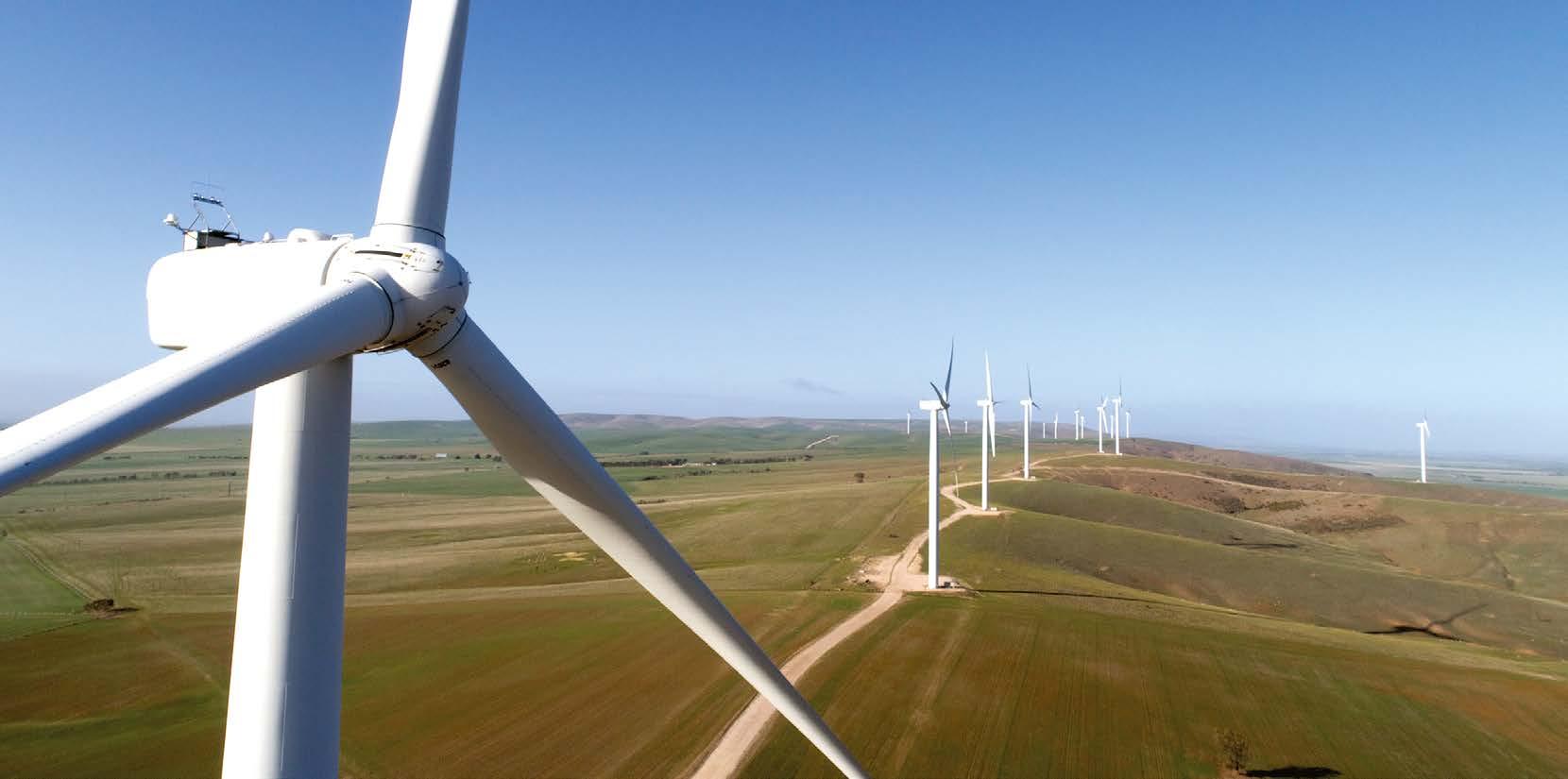
7 minute read
News and views
THE SUNSHINE ENERGY 1.5GW solar PV and 500MW energy storage project in Kilroy, north of Brisbane, will become one of the world’s largest solar farms and boost Queensland’s proportion of renewable energy by 15 per cent to 36 per cent. The $2bn project will also abate ~2,100,000 tonnes of carbon emissions annually and create >1,000 jobs, with up to 60 full-time jobs created for the life of its 25 to 30 year operation.
Construction at the 2,055Ha site which will include ~5 million solar panels will start mid-2019 and be completed in two stages.
Advertisement
BATTERY OF THE NATION ARENA and TasNetworks have assessed feasibility of a second interconnector across the Bass Strait, Project Marinus, that would form a key part of Australia’s future energy network. Under consideration is either a 600 MW or 1200 MW link, delivered in two stages as 600 MW cables, that would use a high voltage direct current cable enabling Tasmania’s vast pumped hydro resources to support the National Energy Market. Hydro Tasmania is accelerating work to identify a pumped hydro project that will be ready to go when a second Bass Strait interconnector comes online.

GLOBAL PRIMARY ENERGY DEMAND will plateau after
2035; electricity consumption will double until 2050, renewables are projected to make up over 50 per cent of generation by 2035 and carbon emissions are projected to decline due to decreasing coal demand. However a 2-degree pathway remains “far away” McKinsey concludes in its comprehensive report Global Energy Perspective.


NEW ANALYSIS SHOWS that
solar PV is more popular in low and middle socio-economic postcodes and on less valuable homes. The report commissioned by Solar Citizens and assembled by Bruce Mountain also found that Australia is using less than a sixth of the total residential rooftop PV potential across the country, so there’s ample opportunity to expand distributed solar.





RENEWABLES DELIVERY MAN The illustrious Simon Corbell recently wrapped up his role as Victoria’s Renewable Energy Advocate in which he placed the progressive state firmly on track toward 25 per cent renewable energy by 2020. Corbell summed his experience thus: “15,000 kms travelled, 25 regional centres visited, reverse auction delivering jobs, supply chains and community benefit.”
With a resume like none other – as an ACT minister he steered the territory to 100 per cent renewables – the man who is a Patron of the Smart Energy Council now heads up the 4000 MW Walcha Energy project. (See page 26.)
Simon Corbell told Smart Energy that the Professor Blaker’s paper suggesting Australia will reach 100 per cent renewables by 2032 was an important contribution that demonstrates the enormous technical capacity of renewable energy development, with storage, to drive down the carbon intensity of the Australian economy. “It has also sparked a timely discussion about how we must overcome the barriers to this potential posed by transmission constraints and a range of other regulatory and policy barriers,” he said.
BIOENERGY AUSTRALIA has appointed
Dr John Hewson as a Director to drive government support for Australia’s future bioeconomy. Bioenergy’s State of the Nation report outlines that Australia is mostly ignoring an energy investment opportunity of as much as $5 billion in urban, agricultural and forest waste that would stimulate regional economies, improve fuel security and reduce emissions. Dr Hewson is widely respected on both sides of the political spectrum and he is a Patron of the Smart Energy Council.
SENSIBLE, BIG ASPIRATIONS We
wonder how much we will hear over the forthcoming months about the US Green New Deal Bill, the far-reaching blueprint to address the climate crisis, and achieve net-zero greenhouse gas emissions in the US while creating jobs and securing clean air and water.
Just the ticket: the US is responsible for a disproportionate one fifth of global greenhouse gas emissions yet has a high technological capacity and ideally would take a leading role in decarbonising electricity, transportation, and industry while restoring ecosystems, upgrading buildings and electricity grids.
Keep pushing.


Smart Energy is printed by Printgraphics whose green credentials include:

SMART THINKING The Smart Energy Council hosted a Smart Energy Manufacturing and Resources Roundtable with shadow Climate Change and Energy Minister Mark Butler. During the in-depth discussion the gathering agreed that strong renewable energy and climate action polices will deliver jobs, investment and business opportunities across regional Australia, with opportunities for manufacturing of smart energy products and development of a smart energy value chain. What’s not to like?
The shift in pool heating throughout Australia is happening fast with the rise of high efficiency pool heat pumps. The struggle for roof space is seeing Australians opting for larger PV installations to offset the running power requirements of electric driven units and moving away from installing traditional rooftop solar, electric element or carbon producing gas pool heating.
A heat pump is classed as a source of renewable energy as it utilises the sun powered ambient air temperature. Using a small compressor pump, heat pumps transform this energy into a higher temperature which is then transferred to the pool water. Heat pump technology has been around for decades, but with the increase in efficiency, usability and ease of installation it is now fast gaining traction in the residential market. Many public baths and commercial pools are already seeing huge savings and carbon reductions by transferring to heat pump technology. With Australia having the highest rate of pools per capita in the world there is certainly no short supply of demand for sustainable pool heating solutions.
Leading the Change
Australian owned heat pump experts, Madimack, are leading this change with their range of full inverter heat pumps which are fully certified by TüV Rheinland. They boast an impressive average coefficient of performance rating of up to 10 by taking advantage of the summer heat and humidity. The inverter technology allows the heat pump to regulate the output from 100% down to 20% ensuring water temperature is maintained consistently and energy is reduced by up to a further 23% than standard on/off units.
Madimack’s philosophy of “Energy Solutions Towards Zero” has catapulted them to the forefront of the solar and renewable market. They assist contractors and distributors by offering expert advice on sizing, performance, installations and integrations. Some of the integrations with BMS, smart homes, dry switches and solar inverter output relays have allowed complete control over how and when customers use their heating. Integrated solutions have been the key to Madimack’s success.
What are the benefits of heat pumps
Pool heat pumps are becoming a lucrative option due to the consistent temperatures achieved throughout the year even when the sun doesn’t shine. With the ability to extract the heat energy from the air down to sub-zero temperatures they allow pools to be heated year-round in all conditions. With the added benefit of not needing a costly gas lines and freeing up valuable roof space for electric production return on investments can be very appealing.
How much energy does a heat pump need?
A heat pump requires only electricity, therefore has the potential to be completely powered by on-site production. With a high coefficient of performance only a fraction of the output is required to power the heater. Compared to electric element heaters, heat pumps are up to 10 x more efficient and operating costs are halved compared to gas systems, even without any other source of on-site electric production.
Running costs c/KWh
MadiMack Pool Heat Pump Natural Gas Boiler LPG Boiler Electric Element
From the CEO
CEO Alex Welsh notes with the success and collaborations made with solar providers and energy experts in 2018 we are now looking to expand our network of installers, retailers and distributors of high efficiency pool heaters throughout all states. Our team of engineers and technicians work alongside renewable energy installers to integrate a seamless solution for their customer’s pool heating with a combination of PV production technology and heat pump technology. With access to our easy to use calculators, technical graphs, drawings and easy to follow installation instructions, installation is a breeze. Our technical and transparent expertise and training allows easy calculations of system size requirements, pool heat up times, energy use and potential savings give the perfect customer experience. The relationship with our preferred partners is a critical piece to the industry shift.
Inquiries are welcome through our National Partnerships Manager Westley Collins Westley@Madimack.com.au or call 1300 899 737
Heat Pump Pool Heaters

elite series | summer eco series | commercial series ` Up to 25 years warranty

`TüV Rheinland Tested
`Highest efficiencies
`WiFi as Standard
`Patented quietest unit
`Full inverter technology









